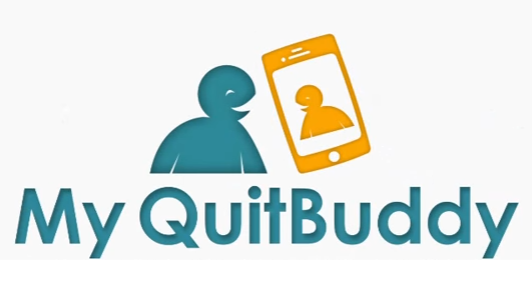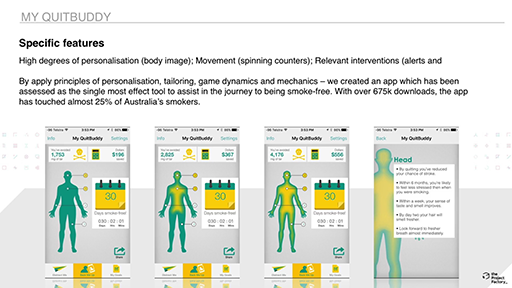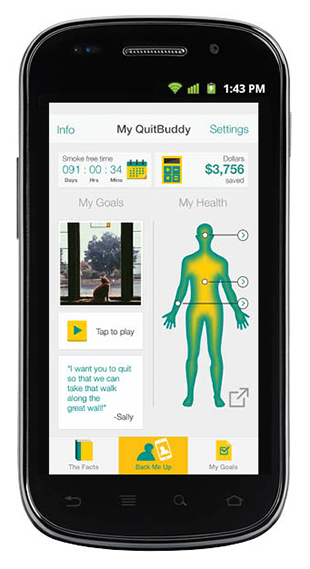Direction 16 Wrap: Giving Up By Design – Jennifer Wilson
Back at Direction last year (that’s the one that’s evolving into Summit this year), Jennifer Wilson gave a compelling talk on using gamification to achieve behavioural change in health practices.
One of the examples she used in her presentation was an app developed by her company The Project Factory for a government health agency, and Jennifer was kind enough to also write the following article for our Wrap magazine, which went into a bit more depth about My QuitBuddy.
It’s a pretty compelling case study and I think you won’t have any trouble seeing where some of this leads.
Giving Up By Design
Jennifer Wilson, Director, The Project Factory

Five years ago, when we at The Project Factory built the Quit Now: My QuitBuddy app for the then Australian National Preventative Health Agency (ANPHA), I realised we had created one of the things I am most proud of in all my 30 years in this industry.
We wanted to build something that would truly help people who wanted to quit smoking achieve their goal.
Designing the app, we channelled smokers we knew, applied everything we’d learned from other projects about what created genuine engagement, and we trod very carefully through deep personalisation, behavioural dynamics and nudge theory to get the balance right.
700,000 downloads later, a clinical assessment has shown that QuitBuddy has the highest effectiveness rating of any quit smoking technique.
I think we got it right.

Changing Behaviour
What we learned from QuitBuddy has influenced all the other work we’ve done, notably in the health field and specifically when addressing any form of behaviour change:
• onboarding that allows the app to be tailored to the individual;
• goal setting to aid in reinforcing intent;
• personal growth feedback that enhances the intrinsic benefits of change;
• gamified elements to encourage adherence and continued use;
• permitted failure – where you can fail without major penalties;
• and careful support through timed alerts, checkins and distractions.
One thing that seems to really work is the ‘slip-up’ test. We ask those on the quitting journey if they are still smoke-free, or if they ‘slipped up’. If they do slip up, we then ask if it was ‘just a slip-up’ or if they need to restart their program.
There’s no rebuke, no reprimand – just a suggestion they identify triggers to help stop this happening again.
Interestingly, over two-thirds of people who say they slipped up do go on to restart their program – a fabulous level of personal honesty.
Vice Control
We’re now in a fascinating new space that really extends what we know.
Smoking, like a few other negative behaviours (abuse, violence, bullying, etc) is binary: you either smoke or you don’t. While some claim to be social smokers, most of us recognise this as a black and white issue.
But what about drinking? Or the odd recreational line of coke, tab of ecstasy or marijuana joint? Or the occasional night on the pokies? Or even that maxed out credit card, and those unworn dresses or shoes?
I knew someone who so looked forward to their one glass of wine at the end of the day, they decided they had a real problem and so signed up to AA. Conversely, I’m sure we all know someone who thinks that a few bottles of wine a night or half a bottle of spirits isn’t adversely affecting them. Sure, they know it’s too much, but it isn’t having a negative impact on their life and they feel in control.
Looking at behavioural change in this space is different. It is less about supporting someone on a journey to be free of a bad habit or vice, and more about helping them determine if they actually are in control of their behaviour, and whether they are really aware of its impact.
The same elements we used for QuitBuddy do come into play, but need to be applied differently and some new tools need to be used. We need to set a baseline for behaviour, check in with the participant to assess how they feel about what they are doing, and get some understanding of their circumstances, moods, relationships, etc. This then forms a baseline we can track them against.
Some, but not all, people will have goals – and where they do, the process of defining a program to reach these goals becomes our primary task. This is more straightforward and similar to cessation goal setting: set the target; work out the steps, timeline and process to achieve this; motivate them along the way; support them where they fail; and encourage them to try again.

Making Honest Choices
We still need to make the experience as personal as possible – in many cases we are asking people to share what might be embarrassing or even illegal habits with us. Our feedback must then be honest, direct and targeted personally to them.
We need, over time, to carefully repeat all those initial questions we asked in the beginning when we were setting a baseline. These need to be phrased differently, to come up at random times, to be appropriate questions to what they were looking at in the app – and definitely not feel intrusive.
We can then report back to them on any impacts their behaviour appears to be having on their lives based on their own self-assessment. This might be increased mood swings, a worsening of a work or family situation, higher levels of anxiety, stress or financial concern, or an increase in recognised risk behaviour (eg unsafe sex).
From here, the participant can choose their path. It might simply be seeking more information on the impacts of their activity – increasing their awareness and helping them make better
decisions. Or it might be that they choose to take more control over their behaviour and work to reduce this to a point where they are more in control.
Regaining Control
It is this sense of control that is the key: whether it is to quit smoking, increase exercise, control our shopping instincts or even learn to deal with our anger.
Digital offers uniquely personal and intimate support to help us be the governors of our actions. I believe that, as we explore this area, we can potentially develop a tool – a generic process – that can be applied to any behaviour where we need to reassert our control over the activity.
Which is just as well, as once we have our analogue habits under control, we may well need to apply this to our digital addictions!

Got your ticket for Summit 17 yet?
Last year’s Direction has morphed into this year’s Summit – two days and two tracks of presentations crammed with ideas, challenges, techniques and breakthroughs in design, development and the overarching themes and concerns driving the breakneck evolution of our web and digital industry. It all takes place in Sydney on 9-10 November. Come and join us!
Want more?
Like to see and read more like this? Be the first to score invitations to our events? Then jump on our once-a-fortnight mailing list to keep up with everything happening at Web Directions, as well as regular bursts of links to relevant articles & resources curated by John Allsopp – and we can promise you some exclusive and substantial subscriber benefits.
Great reading, every weekend.
We round up the best writing about the web and send it your way each Friday.
